Table of Contents
ToggleFrequently described by a certain stylistic character, Islamic geometric patterns art is not confined to the artistic presentation of spiritual worship. It includes all art shapes common in Muslim civilization, both inside and beyond the Middle East. While unique elements of Islamic art manage to show provincial impacts and junctions with the art of other civilizations, they often depict notions and emotions rather than tangible material objects. It is infrequent to see images of individuals in Islamic art, as some regard it as a condition of idols, which is not allowed in Islam. Considering that, Islamic art over time has mainly concentrated on line drawing and geometric design as opposed to statues and drawing.
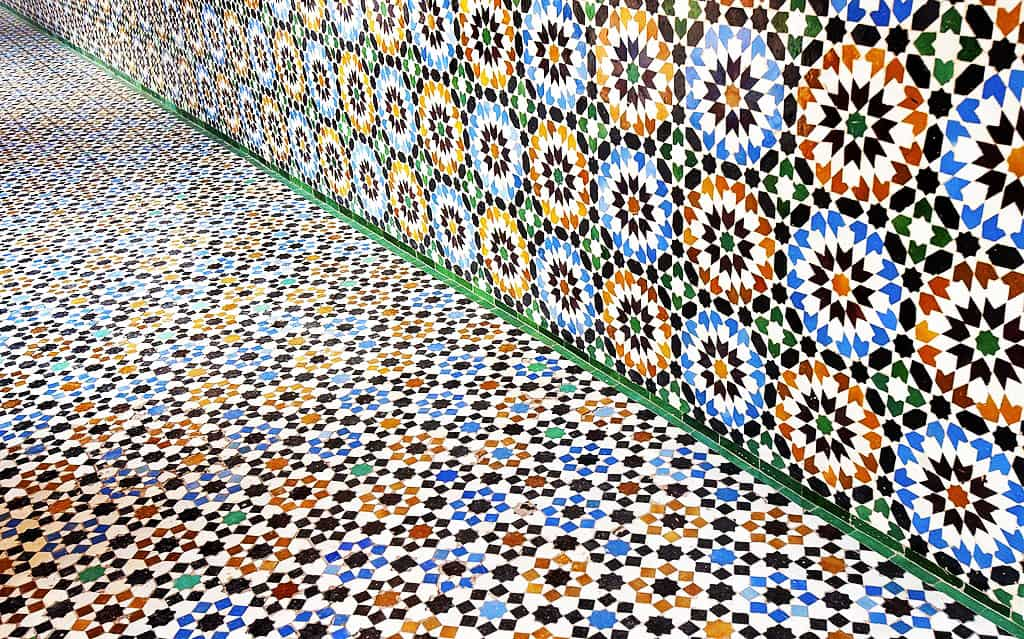
Moroccan tile background – Islamic geometric patterns
Islamic designs are usually made of a series of circles and squares, duplicated, overlaid, and interwoven to form very elaborate and intricate patterns. Geometric patterns mirror the harmony and order of the universe while providing the artist with an amazing level of flexibility and independence. Such designs turned common configurations into incredible creations of art. This is another consideration of a fundamental principle of Islam: the belief that God and Islam inspire life and make it more captivating. Geometric motifs are used to decorate forts, mosques, graves, and houses. It is also utilized for ornamental bowls and mosaics.
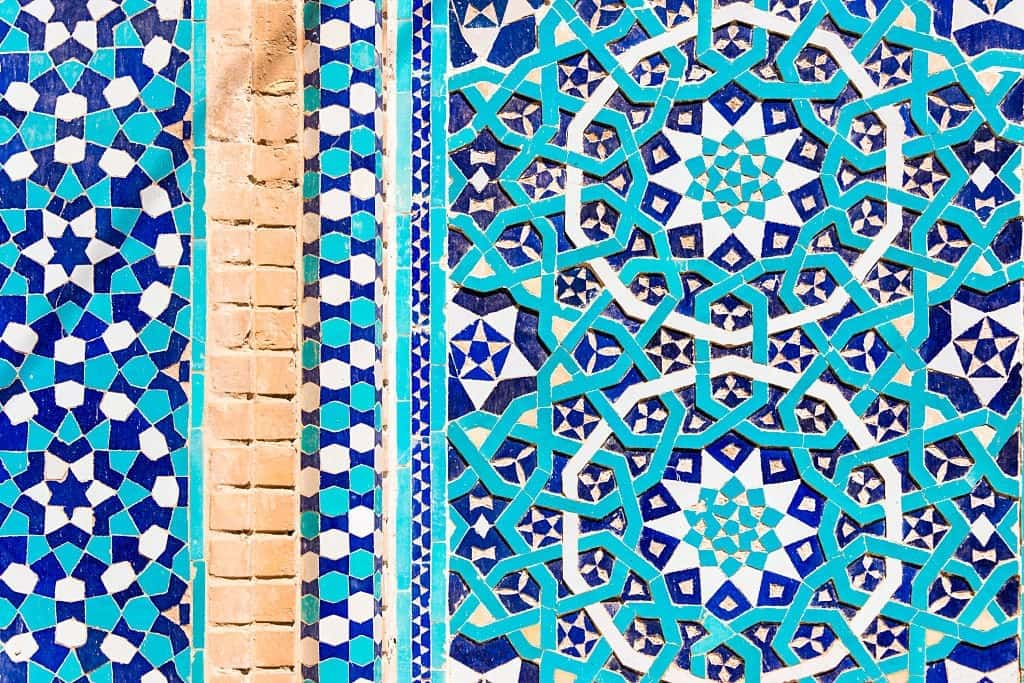
Beautiful Persian tile work at Jame mosque, Yazd, Iran
Considerable geometric configurations contain Islamic designs with flowing lines motivated by plant forms. In Muslim art, they bring the form of duplicated flower or leaf patterns that cross with other figures to form an elaborate pattern. The most typical plant form utilized in Islamic arabesques is the acanthus, which is a plant native to the Mediterranean.
Islamic art is a manifestation of spiritual and cultural importance. The artistic coherence of Muslim art originates from the main doctrines of unity and the oneness of God at the core of this belief. The goal of Islamic art is not to make a replica of what already exists, and any replica is incapable of God’s creation.
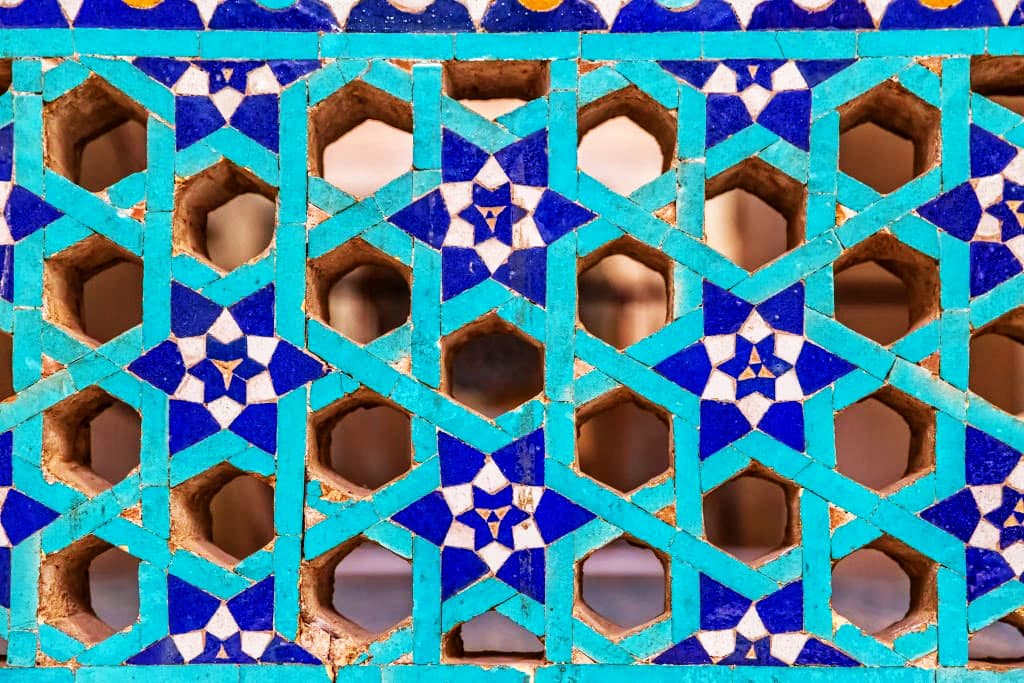
Old and traditional decoration as facade detail – Yazd – Iran
Geometric patterns are believed to reflect the unlimited character of God in various forms. For instance, circles contain no start and end. The complicated and duplicative geometric motifs in Islamic art create the belief that even the most miniature part of the pattern plays a role in the limitless duplication of the total. In addition to Muslims who use geometric forms and script in their art, the ancient Romans, Greeks, and Sasanians also utilized identical designs. But in Islamic cultures, mathematicians and scientists had an important role in creating the complex structures of Islamic geometric art that we notice currently. The four main classes of shapes in geometric Islamic techniques are circles, squares, quadrilaterals, six-pointed stars, and other polygons.
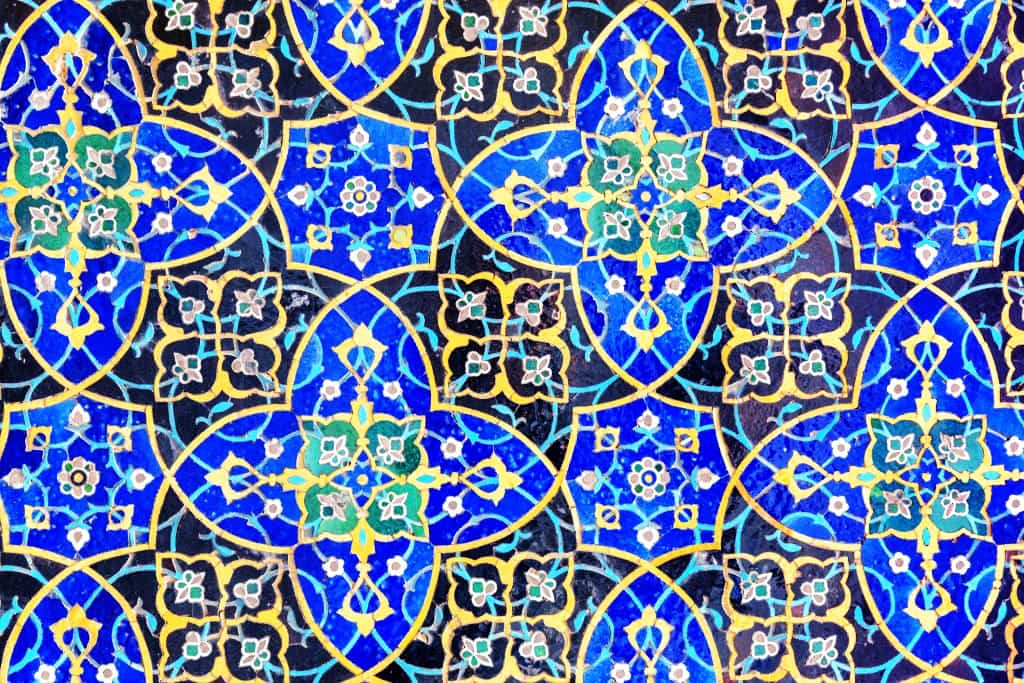
Traditional Persian curvy pattern tile decoration – Isfahan Jame Mosque – Iran
In Islamic art, the star radiates the same radiance in all directions, emanating from the main point. In the Qur’an, the only incarnation of God was referring to light. It was stated that God is the light of the paradises and the earth. So it was solely realistic that the stars in the paradises that make the light seen from Earth would acquire such symbolic power.
In the designs, all the stars are created by a circle that is proportionally divided into identical pieces. The hub of the star is the hub of the circle, the base of its design where each vertex of the star encounters the circle in its circumference. The circle itself has a significant symbolic function, with numerous spiritual purposes. Circles are of ancient geometric characters and have been utilized throughout the past to express unity, ideals, and endlessness. Without a start or end, the circle highlights the One God. Then, the rays of the star extend outwards, representing the spread of Islam.
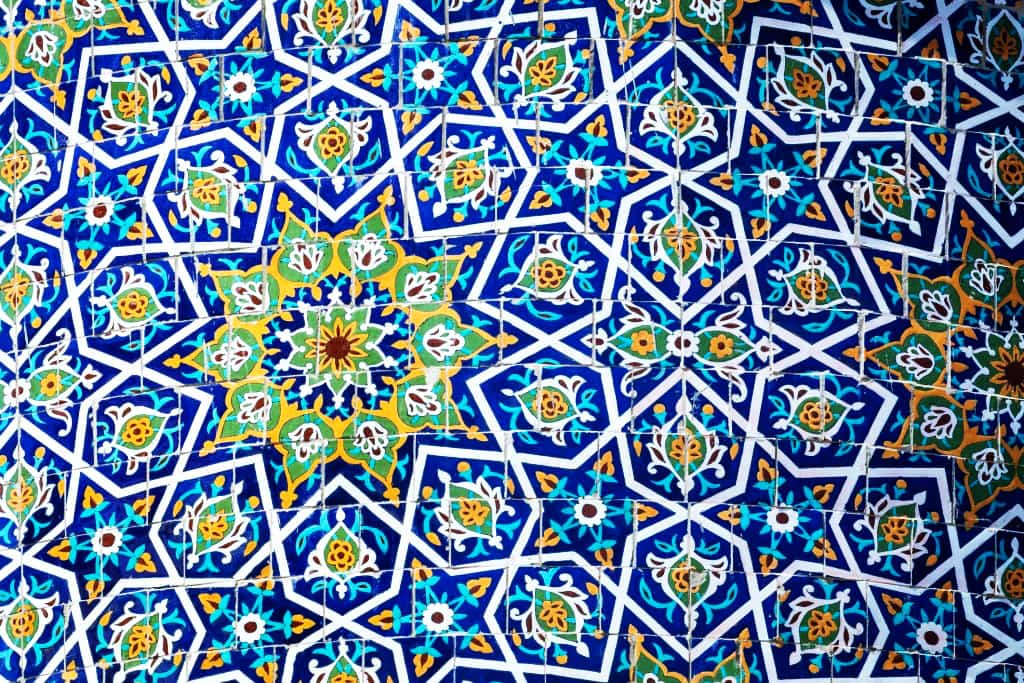
Decorated dome at Barak Khan madrasah Tashkent – Uzbekistan
Also, at the beginning of Islam, the foremost Muslims settled in the deserts of present-day Saudi Arabia. They lived there and used the stars to navigate the desert and the sea. The stars were also important to Muslims in prayer. They were utilized to locate the Qiblah direction to determine the right path for prayer. As a consequence of this procedure in Islam, which was very important in the life of early Muslims, it is not unexpected that stars became so prominent in Islamic art.
Islamic geometric art
Islamic geometric art is a mesmerizing form of artistic expression that has captivated people for centuries. Rooted in the Islamic faith and culture, this art form encompasses intricate geometric patterns that are rich in symbolism, mathematical precision, and aesthetic beauty. Islamic geometric art can be found in various mediums, including architecture, ceramics, textiles, and manuscript illumination.
One of the distinguishing features of Islamic geometric art is its strong emphasis on geometric shapes, such as circles, squares, triangles, and polygons. These shapes are meticulously arranged, interlocked, and repeated to create complex patterns that are both visually stunning and intellectually intriguing. The geometric patterns often exhibit symmetrical designs, reflecting a sense of balance and harmony.
Islamic geometric art carries deep symbolism and meaning. It is believed to reflect the divine order and the underlying structure of the universe. The precision and mathematical principles used in its creation are seen as a manifestation of the perfection and unity of God. Islamic geometric patterns also symbolize spiritual concepts, such as infinity, transcendence, and unity.
This art form has left an indelible mark on Islamic architecture. Magnificent mosques, palaces, and madrasas across the Islamic world showcase the intricate beauty of geometric patterns. From the mesmerizing tile work of the Alhambra in Spain to the breathtaking muqarnas vaulting of the Sheikh Lotfollah Mosque in Iran, Islamic geometric patterns adorn architectural spaces, creating a sense of awe and tranquility.
Islamic geometric art has also found expression in other forms of decorative arts. Ceramics and tiles are adorned with complex geometric patterns, creating vibrant and visually striking designs. Textiles and carpets feature intricate weavings that incorporate geometric motifs, showcasing the skill and artistry of Muslim craftsmen.
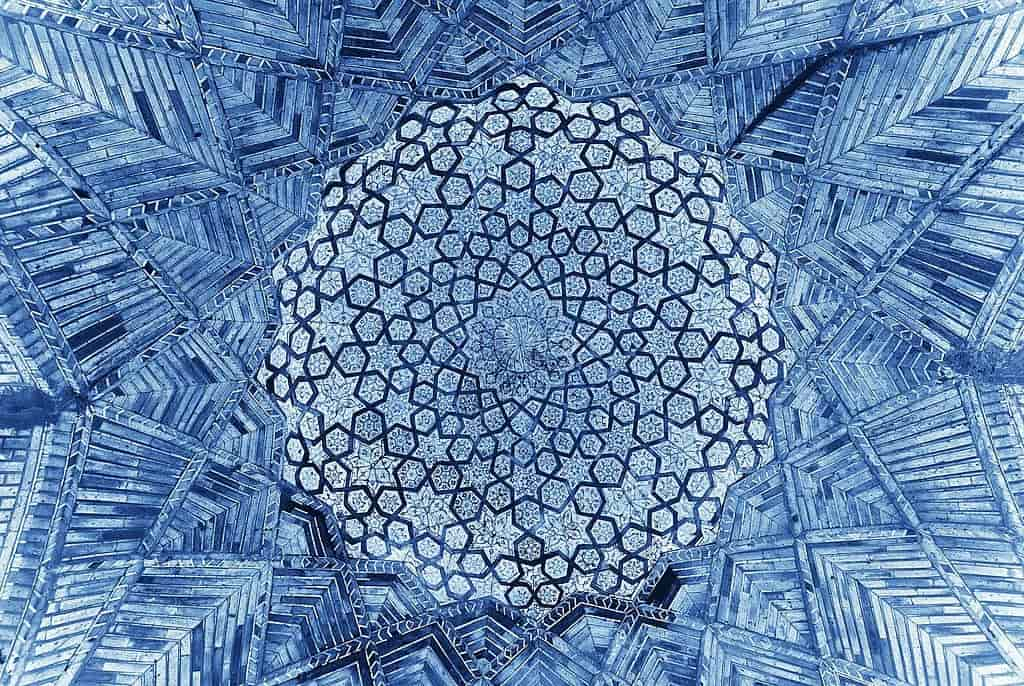
In recent years, Islamic geometric art has experienced a revival and gained recognition in the contemporary art world. Artists and designers draw inspiration from traditional Islamic geometric patterns, incorporating them into modern art, fashion, and interior design. This fusion of traditional and contemporary aesthetics serves to keep the rich heritage of Islamic geometric art alive and relevant.
Islamic geometric art is a testament to the mastery of Islamic artisans, their profound understanding of mathematics and geometry, and their devotion to expressing the beauty of their faith. Its enduring appeal continues to inspire and captivate individuals around the world, fostering an appreciation for the rich cultural heritage of Islamic art.
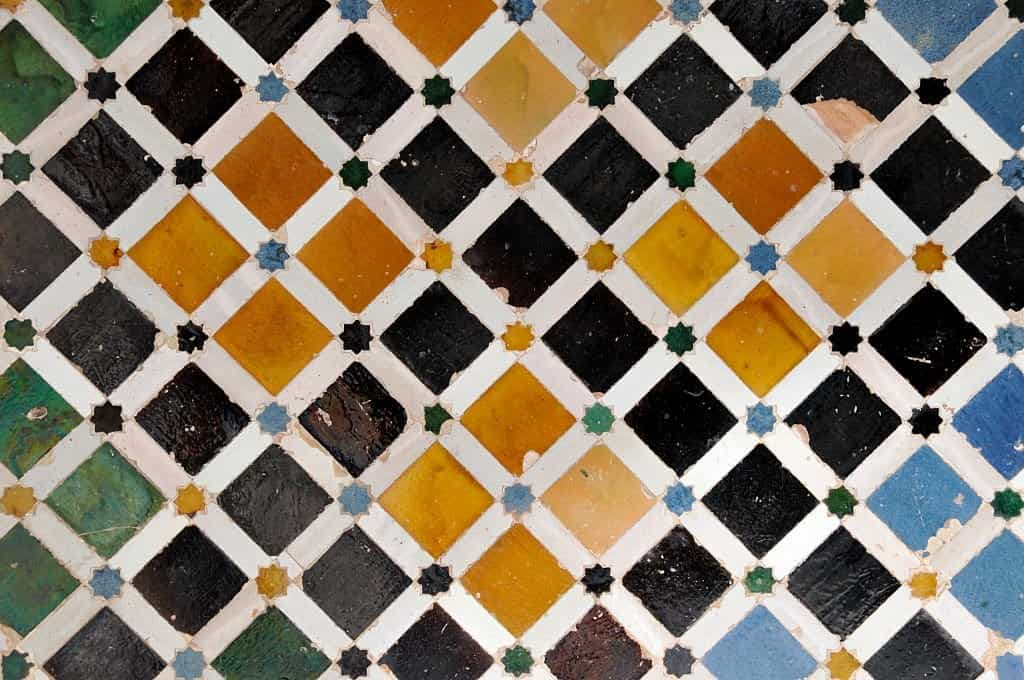
Islamic geometric patterns
Islamic geometric patterns are a remarkable aspect of Islamic art and design, renowned for their intricate beauty, mathematical precision, and symbolic significance. These patterns have a rich history and can be found in various forms of Islamic artistic expression, including architecture, calligraphy, ceramics, textiles, and decorative arts.
Islamic geometric patterns are characterized by their use of geometric shapes, such as circles, squares, stars, and polygons, which are arranged and interconnected in complex and symmetrical compositions. These shapes are often repeated, interlocked, and overlapped to create mesmerizing patterns that seamlessly flow and extend infinitely. The repetition and interlocking nature of these patterns symbolize the infinite nature of God and the interconnectedness of all creation.
One of the most common types of Islamic geometric patterns is the arabesque. Arabesques are intricate and decorative designs composed of intertwining plant motifs, geometric shapes, and calligraphic elements. They are often seen in architectural ornamentation, such as on the walls, ceilings, and domes of mosques, as well as in illuminated manuscripts.
Another prevalent type of Islamic geometric pattern is the tessellation. Tessellations are repeating patterns of geometric shapes that fit together without any gaps or overlaps. They can be found in tile work, where tiles with different geometric motifs are arranged to form intricate and harmonious compositions.
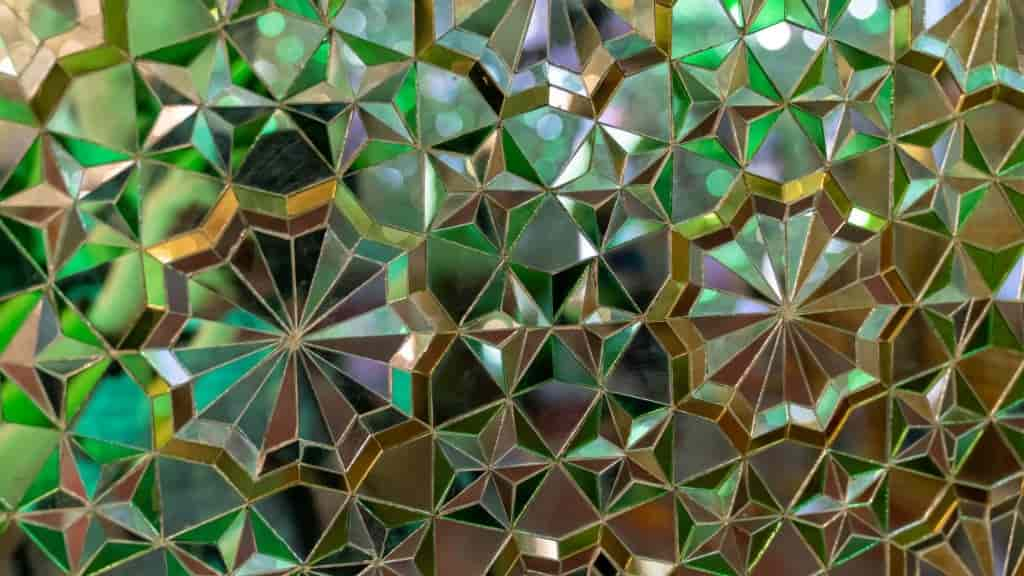
The principles of symmetry and mathematical precision are essential in the construction of Islamic geometric patterns. Islamic artists and craftsmen employed mathematical principles, such as compass and straightedge constructions, to achieve precise proportions, angles, and measurements in their designs. These patterns often adhere to mathematical ratios, such as the golden ratio, to create aesthetically pleasing compositions.
Islamic geometric patterns are not merely decorative; they carry profound symbolism and spiritual meaning. They are believed to reflect the underlying order and unity of the universe, representing the divine harmony and perfection. The complexity and intricacy of these patterns also serve as a reminder of the infinite wisdom and creativity of God.
Today, Islamic geometric patterns continue to inspire artists, designers, and architects worldwide. They have transcended their cultural and religious origins, finding applications in contemporary art, design, and even digital media. The enduring appeal of Islamic geometric patterns lies in their timeless beauty, intellectual depth, and the sense of awe and wonder they evoke in those who encounter them.
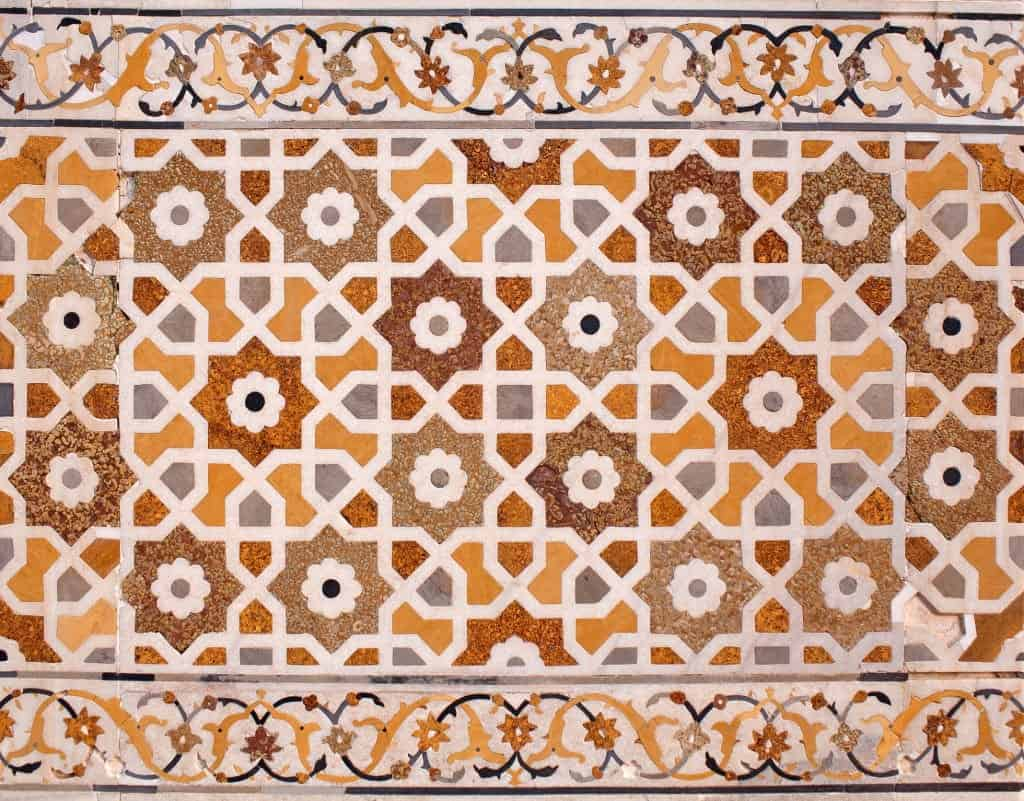
Geometric pattern names
Islamic geometric patterns are a testament to the rich artistic heritage of Islamic art, featuring a diverse array of intricate designs, each with its own unique name and characteristics. These patterns not only exhibit stunning visual beauty but also carry deep cultural and historical significance. Let’s explore some additional details about these notable geometric pattern names commonly found in Islamic art, expanding upon their characteristics and applications.
Arabesque
Arabesques are renowned for their intricate and decorative nature. They embody a harmonious fusion of plant motifs, geometric shapes, and calligraphic elements. The flowing and curvilinear patterns of arabesques often grace the surfaces of Islamic architecture, manuscripts, and textiles, creating a sense of organic beauty.
Girih
Girih patterns are prevalent in Iranian Islamic architecture, showcasing exquisite interlocking stars and polygons. These meticulously crafted designs result in captivating symmetrical compositions. Girih patterns often adorn mosques, palaces, and mausoleums, exemplifying the mathematical precision and artistic ingenuity of Islamic craftsmen.
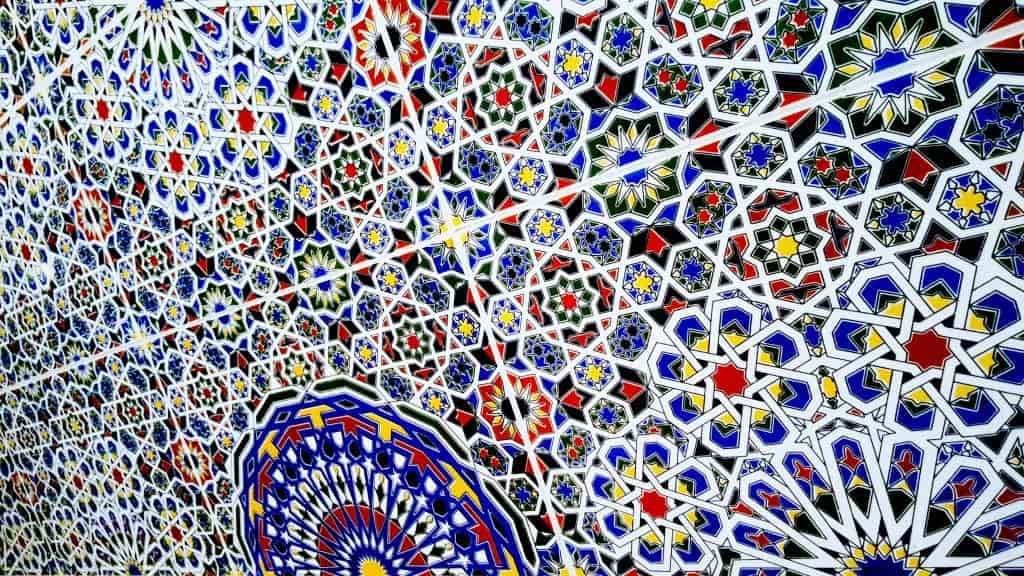
Zillij
Zillij, also known as Moroccan tilework, is renowned for its complex geometric patterns. This form of Islamic mosaic tilework features intricate arrangements of small, vibrant ceramic tiles. Zillij patterns embellish the walls, floors, and fountains of mosques, palaces, and other architectural marvels in Morocco, reflecting the mastery of Islamic artisans.
Muqarnas
Muqarnas is a three-dimensional geometric pattern that has become an iconic feature of Islamic architecture. It consists of interlocking niches or cells, forming a mesmerizing honeycomb-like structure. Muqarnas adorn ceilings, domes, and entrance portals of mosques and palaces, creating a sense of awe and architectural splendor.
Interlacing Patterns
Interlacing patterns display a series of intertwining lines and shapes, resulting in an interwoven and symmetrical design. These patterns are commonly found in Islamic manuscript illumination, where they grace the borders and margins of beautifully crafted pages. They also embellish textiles, such as carpets and fabrics, adding a touch of elegance to Islamic decorative arts.
Rosette Patterns
Rosette patterns are characterized by circular or radial designs, often featuring the repetition of petals, leaves, or other motifs around a central point. These captivating patterns can be found in the decoration of domes, ceilings, and mihrabs (prayer niches) of mosques. Rosettes symbolize the cyclical nature of life and the eternal beauty found in Islamic spirituality.
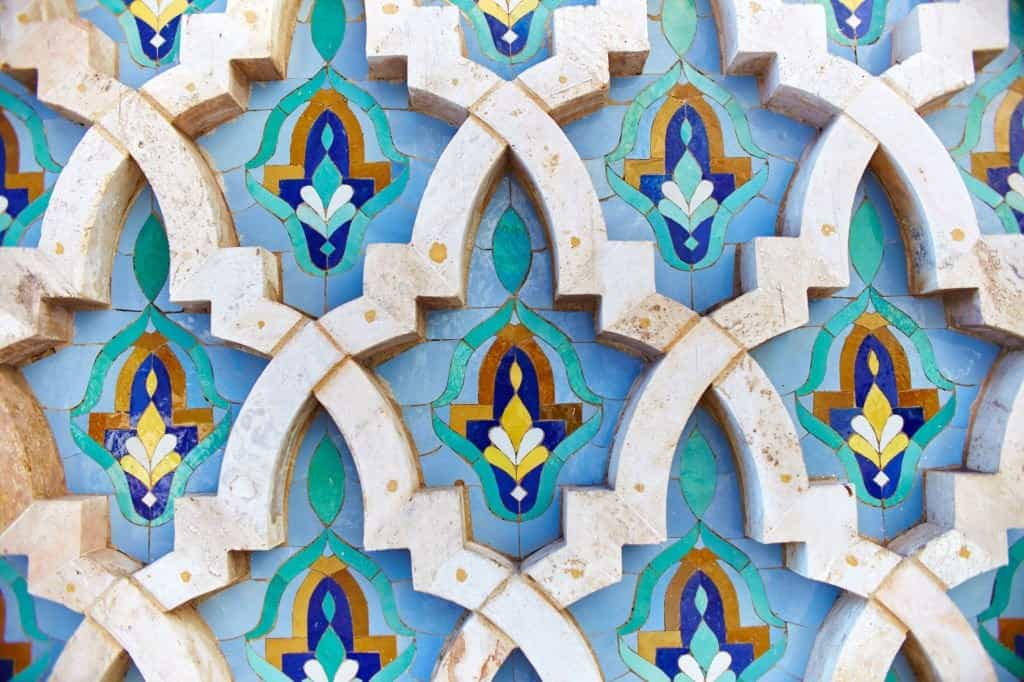
Strapwork
Strapwork patterns exhibit intricate interlaced straps or ribbons that form geometric shapes and motifs. They are commonly seen in Islamic woodwork, stucco decoration, and manuscript illumination. Strapwork patterns add depth and complexity to architectural surfaces and artistic compositions, showcasing the skill and craftsmanship of Islamic artisans.
Squinches
Squinches are architectural elements used to transition from a square or rectangular base to a circular dome in Islamic architecture. They often feature intricate geometric patterns and muqarnas structures, acting as decorative supports. Squinches add structural stability and visual appeal to the transition between different architectural elements, exemplifying the seamless integration of geometric design principles.
These are just a glimpse of the diverse range of geometric pattern names found in Islamic art. Each pattern holds a significant place in Islamic artistic traditions, reflecting the ingenuity, cultural heritage, and spiritual symbolism deeply rooted within Islamic geometric design. These patterns continue to inspire and captivate individuals worldwide, serving as a testament to the enduring legacy of Islamic art and its timeless allure.
Islamic art patterns
Islamic art patterns encompass a wide array of intricate and captivating designs that have evolved over centuries, reflecting the rich cultural heritage of the Islamic world. These patterns, characterized by their geometric complexity, arabesques, and calligraphic elements, hold deep symbolism and serve as a visual representation of Islamic spirituality. Here are some notable Islamic art patterns:
- Geometric Patterns: Geometric patterns are a hallmark of Islamic art. They utilize geometric shapes, such as circles, squares, triangles, and stars, to create intricate and symmetrical designs. These patterns often incorporate repetitive and interlocking elements, demonstrating mathematical precision and a sense of harmony.
- Arabesque Patterns: Arabesques are elaborate and ornamental patterns that combine flowing and curvilinear motifs inspired by plants, flowers, and vines. These intricate designs can be found in various art forms, including architecture, ceramics, textiles, and manuscript illumination. Arabesques represent the interplay between the spiritual and natural worlds, symbolizing the unity and beauty of creation.
- Calligraphic Patterns: Calligraphy, the art of beautiful writing, is highly regarded in Islamic culture. Arabic script is often incorporated into artistic compositions, creating intricate calligraphic patterns. Quranic verses, prayers, or other sacred texts are transformed into visual forms, with the curves and lines of the script becoming part of the overall design.
- Floral Patterns: Floral motifs hold a significant place in Islamic art. These patterns feature stylized depictions of flowers, leaves, and vines, often arranged in repetitive and symmetrical compositions. Floral patterns symbolize the beauty and abundance of nature and serve as a reminder of the divine creation.
- Tessellations: Tessellations are repeating patterns of interlocking geometric shapes that fit together seamlessly, creating a continuous and balanced design. Islamic art is renowned for its mastery of tessellations, with patterns that can extend infinitely without gaps or overlaps. Tessellations are found in architectural tile work, mosaics, and intricate carpets.
- Illuminated Manuscripts: Islamic illuminated manuscripts are adorned with intricate patterns and designs. These manuscripts often feature ornate borders, illuminated initials, and intricate geometric patterns that enhance the beauty and readability of the text. The pages are meticulously decorated with gold leaf, vibrant colors, and meticulous details.
Islamic art patterns encompass a diverse range of styles and motifs, yet they all share a common thread of spiritual symbolism, mathematical precision, and aesthetic beauty. These patterns continue to inspire and captivate individuals worldwide, serving as a testament to the rich cultural heritage of Islamic art and its enduring legacy.
Read more: Types of Islamic geometric patterns
Islamic geometric patterns tutorial
If you’re fascinated by the mesmerizing beauty of Islamic geometric patterns and would like to learn how to create them, this tutorial will guide you through the basic steps:
- Understand the Principles: Islamic geometric patterns are based on mathematical principles, symmetry, and precise proportions. Familiarize yourself with the fundamental geometric shapes, such as circles, squares, triangles, and polygons, and their properties. Study the principles of symmetry, including reflection, rotation, and translation.
- Start with a Grid: Begin by creating a grid on your paper or digital canvas. The grid will serve as a guide for constructing the geometric shapes and maintaining symmetry. You can use a ruler, compass, or digital drawing tools to create an accurate grid.
- Choose a Central Shape: Select a central shape, such as a circle or a polygon, as the starting point for your pattern. Place it at the center of your grid.
- Repeat and Interlock: Using the grid as a reference, repeat the central shape and interlock it with neighboring shapes. Pay attention to symmetry and ensure that the shapes align perfectly along the grid lines.
- Add Detail and Complexity: Once you have established the basic interlocking pattern, start adding smaller shapes and lines to enhance the complexity of the design. Experiment with different variations and combinations of shapes to create visually captivating patterns.
- Embrace Symmetry: Islamic geometric patterns often feature symmetrical compositions. Explore different types of symmetry, such as radial symmetry, bilateral symmetry, or translational symmetry. Use mirror imaging or rotation to create symmetrical repetitions.
- Refine and Finalize: Refine your design by adjusting the proportions, curves, and angles of the shapes. Pay attention to the details and ensure that the pattern flows seamlessly. Erase any unnecessary grid lines and clean up the drawing.
- Explore Color and Materials: Islamic geometric patterns can be further enhanced by adding colors and textures. Experiment with different color schemes, textures, and materials to bring your pattern to life. Traditional Islamic art often employs vibrant hues and intricate tilework.
- Practice and Experiment: Creating Islamic geometric patterns requires practice and experimentation. Start with simple designs and gradually challenge yourself with more intricate compositions. Study traditional patterns and explore contemporary adaptations to broaden your understanding and creative possibilities.
Remember, the process of creating Islamic geometric patterns is as important as the final result. Embrace the precision, patience, and meditative nature of this art form. With time and practice, you’ll develop your own unique style and create stunning geometric patterns that pay homage to the rich heritage of Islamic art.
Step-by-Step Guide to Creating Islamic Geometric Patterns
Step 1: Understand the Principles Familiarize yourself with the fundamental principles of Islamic geometric patterns. Study the basic geometric shapes, symmetry, and proportions. Learn about the principles of reflection, rotation, and translation.
Step 2: Gather Materials Collect the necessary materials for your project, such as paper, pencil, ruler, compass, and eraser. These tools will help you create precise and accurate geometric constructions.
Step 3: Start with a Grid Begin by creating a grid on your paper. Use a ruler to draw equally spaced horizontal and vertical lines. The grid will serve as a guide for constructing your pattern and maintaining symmetry.
Step 4: Choose a Central Shape Select a central shape as the focal point of your pattern. It could be a circle, square, or polygon. Place it at the center of your grid.
Step 5: Repeat and Interlock Using the grid as a reference, repeat the central shape and interlock it with neighboring shapes. Ensure that the shapes align perfectly along the grid lines. Maintain symmetry and proportion as you extend the pattern.
Step 6: Add Detail and Complexity Once you have established the basic interlocking pattern, start adding smaller shapes and lines to enhance the complexity of the design. Experiment with different variations and combinations of shapes to create visually captivating patterns.
Step 7: Embrace Symmetry Islamic geometric patterns often feature symmetrical compositions. Explore different types of symmetry, such as radial symmetry or bilateral symmetry. Use mirror imaging or rotation to create symmetrical repetitions.
Step 8: Refine and Finalize Refine your design by adjusting the proportions, curves, and angles of the shapes. Erase any unnecessary grid lines and clean up the drawing. Pay attention to the details and ensure that the pattern flows seamlessly.
Step 9: Explore Color and Texture Consider adding color and texture to your pattern to enhance its visual appeal. Experiment with different color schemes, textures, and materials. Traditional Islamic art often employs vibrant hues and intricate tilework.
Step 10: Practice and Experiment Practice creating Islamic geometric patterns regularly. Start with simple designs and gradually challenge yourself with more intricate compositions. Study traditional patterns and explore contemporary adaptations to expand your creative possibilities.
By following these steps and allowing your creativity to flourish, you can create stunning Islamic geometric patterns that reflect the beauty and precision of this art form.
FAQ
What is the significance of Islamic geometric patterns?
Islamic geometric patterns hold cultural, religious, and aesthetic significance. They reflect the interconnectedness of spirituality and mathematics, symbolize the infinite nature of God, and showcase the artistic excellence of Islamic civilizations. These patterns also create a sense of harmony, beauty, and tranquility in architectural spaces and decorative arts.
Can anyone create Islamic geometric patterns, or is it limited to skilled artists?
Islamic geometric patterns can be created by anyone with an interest in the art form. While skilled artists may produce intricate and complex designs, beginners can start with simpler patterns and gradually progress. Patience, practice, and an understanding of geometric principles are key. Various tutorials, resources, and workshops are available to guide individuals of all skill levels in creating their own Islamic geometric patterns.

6 Responses
That was fantastic. Thanks a lot
You’re welcome! I’m thrilled to hear that you found my article fantastic. If you ever need help or have more questions in the future, don’t hesitate to ask. Happy learning and have a wonderful day Ali!
I’m a college student and studying art. Islamic geometric patterns are really special and I just wanted to thank you for the tutorial part.
I’m glad to help! It is my pleasure to hear that you found the tutorial on geometric patterns informative and interesting. There is a deep cultural significance to Gereh geometric art, including its intricate geometric patterns.
Wanted to thank you for the video and the informative article! I’ve recently become interested in studying and learning how to draw geometric patterns. Love how relaxing and meditative the process is. The connection to nature and the universe. And I suppose now I’ll have to brush up on math skills which is a bonus. I work in film arts and this is going to be a fun way to generate and explore new art skills. I also enjoy learning history and reading so that’s another bonus!
You’re welcome! I’m glad to hear that you found the video and article informative. It’s great that you’ve taken an interest in studying and learning how to draw geometric patterns. I agree, it can be a very relaxing and meditative process, and it’s fascinating to see the connection between these patterns and nature and the universe. Enjoy!